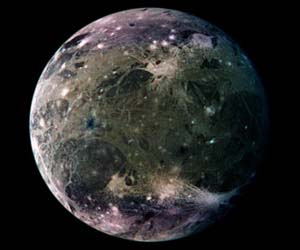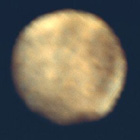|
Jupiter Moon Ganymede
Telescopes for Astronomy
|
Ganymede Normal Colour View

Ganymede Enhanced Colour View

Ganymede Facts
Ganymede is the 7th moon in distance from Jupiter.
It is the largest moon in the solar system.
It has a diameter of 3,270 miles (5,262 km) which is larger than Mercury.
Ganymede would certainly be classed as a planet if it orbited the sun instead of Jupiter.
It orbits Jupiter at a distance of 665,116 miles (1,070,400 km) and takes 7 days 3 hours to make one orbit of the planet.
It is the only moon in the solar system known to have its own magnetic field.
Ganymede is under the same tidal influences as Io and Europa although at a much weaker level.
It is believed that Ganymede has a salt water ocean 124 miles (200 km) below its surface
Ganymede has a low density meaning that even though it is bigger than Mercury it only has half its mass.
The moon was discoverd in January 1610 by the Italian astronomer Galileo Galilei.
Surface, Atmosphere & Temperature
Surface
The surface of Ganymede has two types of terrain. Forty percent is made up of darker areas which are higly cratered. The remaining 60% has lighter areas consisting of grooved terrain. Some of these grooves are
over 700 metres (2,000 feet) in height which run for thousands of miles across its surface.
Atmosphere
Much like Europa's atmosphere Ganymede has an extremely thin layer of oxygen covering it. Its also possibe that
aurorae occur at its poles.
Temperature
Daytime temperatures on the surface average around -113C to -183C (-171F to -297F). At night temperatures plunge even further to around -193C (-315F).
| Origin of Name |
| Life on Ganymede |
Ganymede is named after a handsome mortal prince from Greek mythology who was abducted by Zeus to become cup-bearer to the gods. See Europa for a more detailed explanation.
Chances of life existing in Ganymede are much less than on Europa due to its ocean being much further from the surface.
| Jupiter Moon Ganymede - Images and Videos |
Ganymede causing aurora
Ganymede Flyover
Impact chain


| Future and Past Missions to Ganymede |
Europa Jupiter System Mission
 Launch: 2020
Launch: 2020Agency: NASA/ESA
A joint venture by NASA and the ESA (Europe) will study Europa and Ganymede using two seperate spacecraft. The ESA led Jupiter Ganymede Orbiter (JGO) will map Ganymede's magnetic field and its interactions with Io, Europa and Callisto. It will also set out to characterize the water ocean underneath its surface.
Voyager 1 and 2
 Launch: August-September 1977
Launch: August-September 1977Arrival: April-August 1979
Agency: NASA
Voyager 1 and 2 made successful flybys of Ganymede taking far more detailed images than the previous Pioneer missions. The grooved terrain could be seen and it was also revealed that Ganymede was in fact larger than first thought, replacing Saturn's moon Titan as the largest satellite in the solar system.


